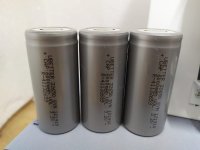Rassy said:
If your charger and BMS are working correctly you will not damage any cells by leaving the charger on until all cells are balanced. You will get different opinions on this, but I always fully charge and balance my LiFeP04 batteries after every ride so they are ready for the next ride. I have helped a number of friends and relatives add electric assist to their bikes and trikes and counting my own two batteries there are 7 other Ping batteries, some as much as 8 years old, that I either helped purchase or even gave to them, and all still balance fully during every charge. The Ping BMS has 16 LEDs that light up when the cell groups each reach full charge so they are easy to check. A few of my friends/relatives did not understand the importance of this and eventually their batteries became way unbalanced. In the worst case it took me two weeks to get the battery fully balanced. That was several years ago and the battery is still performing properly.
Since you are able to check the voltage at the cell (or 3 paralleled cells) level, you can verify that the low cell voltage is slowly increasing, and that the other cell groups are also within proper parameters. Did you balance all cells before you assembled your pack? And if so did you verify that they held their charge? You may have a faulty cell in that one group and it may need to be replaced.
As far as what happens when the battery cuts out you may just be seeing how the discharge curve works with LiFeP04. My 16s batteries hold steady in the 52 to 53 volt range for most of the discharge and then drop off very fast near the end. So I would expect your battery to hold steady several volts lower during use. Those numbers are at rest, and during actual use there will be some voltage sag, which varies depending on how hard you are pushing the battery.
EDIT: I also looked over your post again, and your test at 40 KMH (25 MPH) gave you a range of 30 KM (18 1/2 M) with a max draw of 30 amps (almost 2C on an 18AH battery) doesn't sound too bad. I don't know about your battery specs, but 2C is usually considered a high discharge rate for LiFeP04. Of course how much effort you add makes a difference, but at half the speed you would probably triple your range.
thats great my friend.. you are awsome


i have got all the cells balanced from the seller (3.2v with 0.01v difference)
update: after 3 hrs of charge, now charger got cut off it self by charging the battery to 50.3v (50v stable after removing the charger)
it will not decrease until load is connected.(stable 50v)
now,after checking all 15 cell packs after full charge the voltages are as given
1(-) 2 3 4 5 6 7 8 9 10 11 12 13 14 15(+)
3.35| 3.37| 3.35 |3.35|3.36|3.35|3.36|3.36|3.35|3.35 |3.35 |3.36 |3.35|3.36 |3.35
after disconnecting the charger from battery these voltages are tested and the bms start to get slightly warm after disconnecting the charger.
the voltages of the cells are not stable when charging connected.they are varying from 2.98 to 3.59v
now after checking the voltage of all cells, i am charging it again.
i will update you soon.
after checking the mileage yesterday.i have noticed that,the battery dropped only 2.3v for 22km of range(from 50.3v to 48v) and then it gave me only 8km of range (from 48v to 42v with cut off because of bms protection). is this normal

the charger is showing it fully charged and dropped the amps to 0 now. is it ok to leave this connected


no change in the cell voltages.
i have opened the charger case and found two smd potentiometers labeled as CH-C and CH-V shoud i adjust them

i will discharge the battery after 4 to 5 hrs. and will update you soon
and i have made this battery for my home made recumbent trike which is equipped with 550w gear reduced motor connected as shown in the pictures

40%of the work done

.
till now the motor is an issue and now issue with battery pack :|
i think it will give a lot more mileage on the trike because of its free wheel and the design

.
i have not checked the battery on trike yet.(only checked with 250w hubmotor based escooter)
thanks for being an helping hand..


this is my first battery pack (here our parents wont encourage to do these kind of things. after we get out of school, we only has
3 to 4 choices either to become an engineer,doctor,businessman,etc.

)
 but got no solution other then saying 15 to 20 charge,discharge cycles will make the pack to charge upto 100%.
but got no solution other then saying 15 to 20 charge,discharge cycles will make the pack to charge upto 100%. .
.






